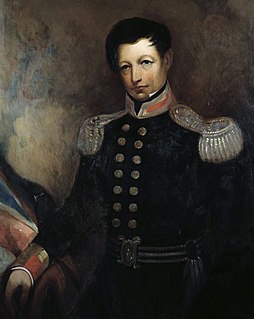
Captain William Hobson was a British Royal Navy officer who served as the first Governor of New Zealand. He was a co-author of the Treaty of Waitangi.
Five ships of the Royal Navy have been named HMS Herald:

HMS Hecla was a Royal Navy Hecla-class bomb vessel launched in 1815. Like many other bomb vessels, she was named for a volcano, in this case Hekla in Iceland. She served at the Bombardment of Algiers. Subsequently she took part in three expeditions to the Arctic. She then served as a survey vessel on the coast of West Africa until she was sold in 1831. She became a merchantman and in 1834 a Greenland whaler. She was wrecked in 1840.
Captain Owen Stanley FRS RN was a British Royal Navy officer and surveyor.

HMS Rattlesnake was an Atholl-class 28-gun sixth-rate corvette of the Royal Navy launched in 1822. She made a historic voyage of discovery to the Cape York and Torres Strait areas of northern Australia.

HMS Discovery was a Royal Navy ship launched in 1789 and best known as the lead ship in George Vancouver's exploration of the west coast of North America in his famous 1791-1795 expedition. She was converted to a bomb vessel in 1798 and participated in the Battle of Copenhagen. Thereafter she served as a hospital ship and later as a convict ship until 1831. She was broken up in 1834.

HMS Pelorus was an 18-gun Cruizer-class brig-sloop of the British Royal Navy. She was built in Itchenor, England and launched on 25 June 1808. She saw action in the Napoleonic Wars and in the War of 1812. On anti-slavery patrol off West Africa, she captured four slavers and freed some 1350 slaves. She charted parts of Australia and New Zealand and participated in the First Opium War (1839–1842) before becoming a merchantman and wrecking in 1844 while transporting opium to China.

HMS Gorgon was a 44-gun fifth-rate two-decker ship of the Adventure class of 911 tons, launched at Blackwall Yard in 1785 and completed as a troopship. She was subsequently converted to a storeship. She also served as a guardship and a hospital ship at various times before being broken up in 1817.
John MacGillivray was a Scottish naturalist, active in Australia between 1842 and 1867.

Sir Richard Collinson was an English naval officer and explorer of the Northwest Passage.
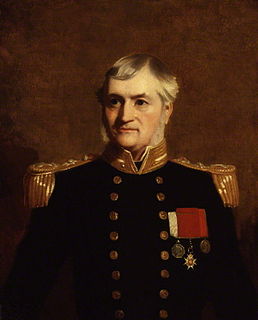
Vice Admiral Sir Henry Kellett, was a British naval officer and explorer.

HMS Griper was a Bold-class gun-brig of the British Royal Navy, built in 1813 by Mark Williams and John Davidson at Hythe. She participated in the 1819 expedition to the Arctic led by William Parry, made a voyage to Greenland and Norway in 1823, and took part in Parry's third expedition in 1824 as a support ship. Her crew in 1819, 1823, or 1824, qualified for the "Arctic Medal", which the Admiralty issued in 1857. She was eventually broken up in 1868.

HMS Hydra was the lead ship of her class of wooden steam paddle sloops of the British Royal Navy, launched in 1838 at Chatham Dockyard. After taking part in operations during Syrian War in 1840, she then served on anti-slavery operations and also as a survey vessel. She was scrapped in 1870.
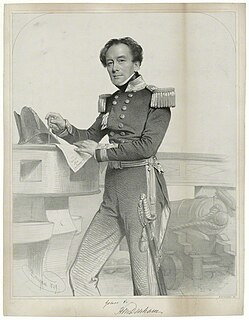
Vice Admiral Sir Henry Mangles Denham was a Royal Navy officer who went on to be Commander-in-Chief, Pacific Station.
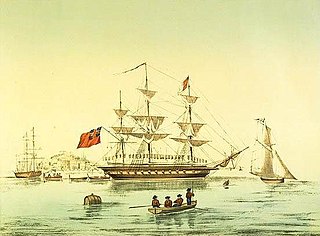
HMS Fly was an 18-gun sloop of the Royal Navy. She was responsible for the exploration and charting of much of Australia's north-east coast and nearby islands. She was converted to a coal hulk in 1855 and broken up in 1903.

HMS Daedalus was a 32-gun fifth rate frigate of the Royal Navy, launched in 1780 from the yards of John Fisher, of Liverpool. She went on to serve in the American War of Independence, as well as the French Revolutionary and Napoleonic Wars.
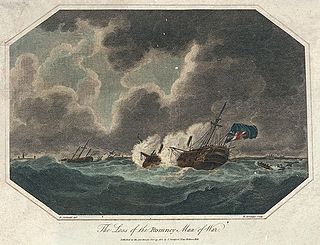
HMS Romney was a 50-gun fourth rate of the Royal Navy. She served during the American War of Independence, and the French Revolutionary and Napoleonic Wars in a career that spanned forty years. Five ships of the Royal Navy have been named HMS Romney. The origins of the name are from the town of New Romney, although it may be that the name entered the Royal Navy in honour of Henry Sydney, 1st Earl of Romney.

HMS Salamander was one of the first paddle warships built for the Royal Navy. Initially classed simply as a steam vessel, she was re-classed as a second-class steam sloop when that categorisation was introduced on 31 May 1844. She was launched in 1832 from Sheerness Dockyard, took part in the Second Anglo-Burmese War and was broken up in 1883.

HMS Racehorse was an 18-gun ship-rigged sloop of the Royal Navy, later refitted as a survey vessel. She was originally the 18-gun French privateer Marquis de Vaudreuil, captured from the French in 1757 during the Seven Years' War, and purchased for the British Navy on 28 April 1757. As she was a three-masted vessel, she was described as a 'frigate', but as she mounted just 18 guns, she was actually registered as a sloop.

HMS Scylla was an 18-gun Cruizer-class brig-sloop of the Royal Navy. The first to bear the name Scylla, she was launched in 1809 and broken up in 1846.


















